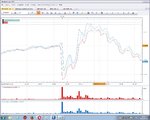asimpleplan
Member
- Messages
- 63
- Likes
- 3
Hi,
Can anyone enlighten me on whipsawing in the intra-minute range on a candlestick chart? On a 1 minute LINE chart, the only information is the closing price ahead of the previous minute's close but of course that doesn't tell the whole story about the whipsawing prices traded in that minute.
So, let's take, for example, the candlestick at 10.01, which closes slightly below the previous close at 10.00.
The whole range is:
(HI)1.12902/(LO)1.2886
(OPEN)1.12901/(CLOSE)1.12982
So, after the price opens, is the assumption that the price whipsaws to the high first and then to the low before closing?
Or, does one assume the price whipsaws ANYWHERE between that range within the minute before closing?
Obviously, in this case (a RED candlestick), common sense dictates that the high would occur soon after the open before whipsawing down and establishing the closing price.
Sorry to labour the point but I need to be certain. Thanks.

Can anyone enlighten me on whipsawing in the intra-minute range on a candlestick chart? On a 1 minute LINE chart, the only information is the closing price ahead of the previous minute's close but of course that doesn't tell the whole story about the whipsawing prices traded in that minute.
So, let's take, for example, the candlestick at 10.01, which closes slightly below the previous close at 10.00.
The whole range is:
(HI)1.12902/(LO)1.2886
(OPEN)1.12901/(CLOSE)1.12982
So, after the price opens, is the assumption that the price whipsaws to the high first and then to the low before closing?
Or, does one assume the price whipsaws ANYWHERE between that range within the minute before closing?
Obviously, in this case (a RED candlestick), common sense dictates that the high would occur soon after the open before whipsawing down and establishing the closing price.
Sorry to labour the point but I need to be certain. Thanks.


